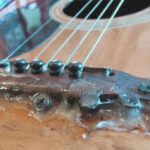Guitar tab reading is a skill every guitarist needs, and this guide will help you master it. At guitarplayers.net, we simplify understanding guitar tablature for beginners, showing you how to read tabs, master guitar techniques, and ultimately play your favorite tunes. Unlock the world of guitar playing with easy-to-follow instructions, and discover resources for advanced techniques, chord charts, and sheet music.
1. What Exactly Are Guitar Tabs?
Guitar tabs, or tablature, are a simplified way of representing guitar music, showing you where to place your fingers on the fretboard. It’s like a visual map that makes learning songs more accessible, especially for beginners.
The guitar tab consists of six horizontal lines, each representing one of the six strings on the guitar. Reading the tab from top to bottom, the lines correspond to the strings from the thinnest (high E) to the thickest (low E). Numbers on these lines indicate which fret to press down on each string. A “0” means you play the string open, without pressing down any fret. Guitar tabs are particularly useful because they show you exactly where to play the notes on your guitar, overcoming the challenge of multiple locations for the same note.
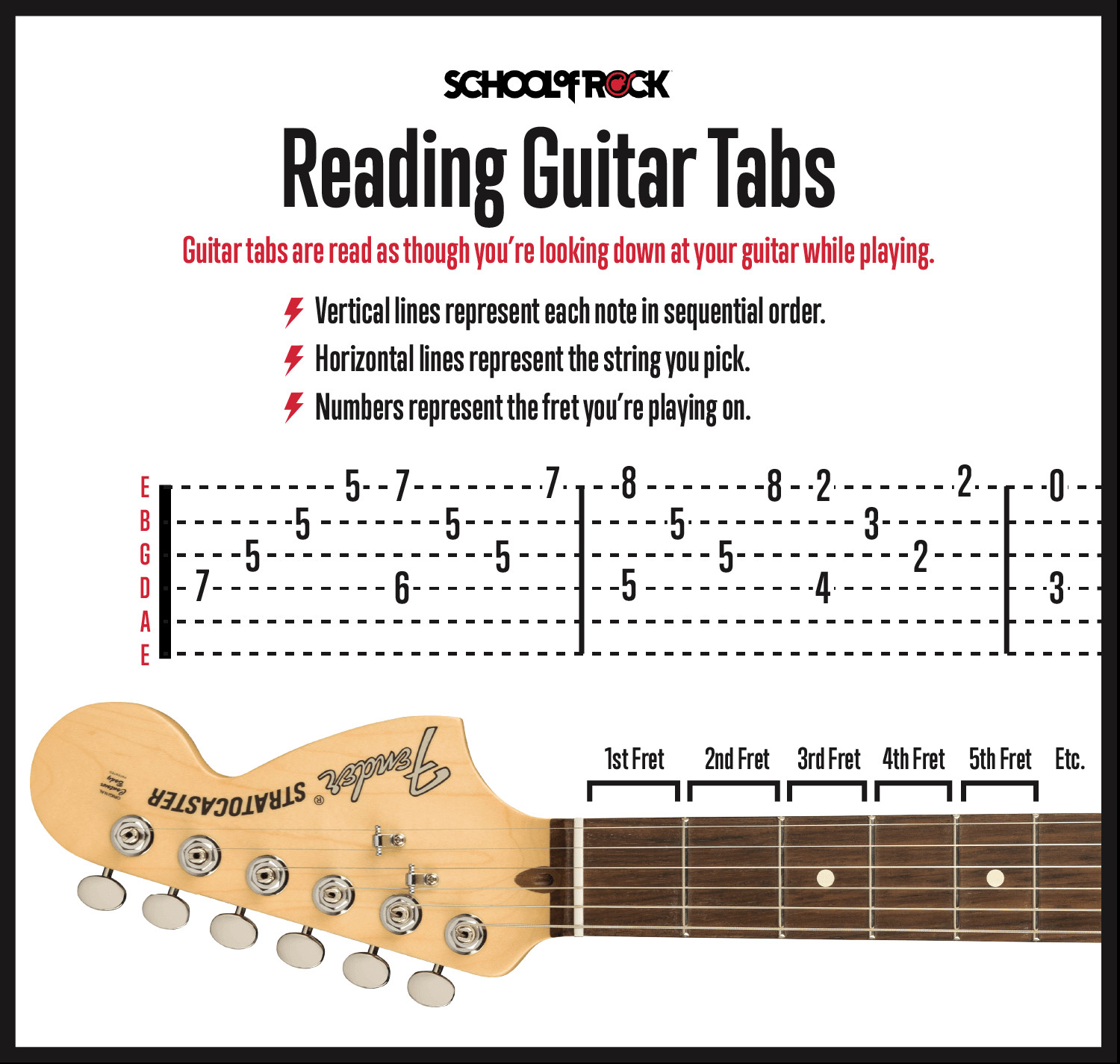 Guitar Tablature Explained
Guitar Tablature Explained
2. How Do I Read Guitar Tabs Effectively?
Read guitar tabs from left to right, just like reading a book, and the notes are played in that order. Notes stacked vertically represent a chord, which you play by strumming all the indicated strings simultaneously. Guitar tabs provide a straightforward way to learn chords and single notes, requiring only basic knowledge of the guitar’s strings and frets.
2.1. What’s Essential to Know for Reading Guitar Tabs?
To successfully read guitar tabs, familiarize yourself with the six strings of the guitar and the location of the frets. This will enable you to locate the correct notes as indicated in the tab.
3. Understanding the Guitar Tab Staff
The guitar tab staff is similar in appearance to the staff used in standard music notation, but it differs significantly in what it represents. In guitar tabs, the lines represent the six strings of the guitar, not musical notes. The top line represents the high E string, and the bottom line represents the low E string. Each line is usually labeled with the string name (E, B, G, D, A, E) to avoid confusion with standard notation. The staff is often labeled “TAB” to clearly indicate that it is a tablature.
4. How to Decipher Guitar Frets on Tabs?
Guitar frets are the metal strips running across the fretboard. Typically, guitars have 19 to 24 frets, with each fret representing a half step (or semitone). There are twelve frets, or notes, in each octave. Fret markers, usually located at the 3rd, 5th, 7th, 9th, and 12th frets, help you quickly identify positions on the fretboard. Numbers on the tab indicate which fret to use: “0” means playing an open string, while “1” indicates the first fret, “2” the second fret, and so on.
5. How to Comprehend Guitar Tab Chords
Chords in guitar tabs don’t have special symbols but are easy to spot. When notes are aligned vertically, they form a chord and should be played together. If a chord is arpeggiated, the notes will appear individually, even though you’re still holding the chord shape.
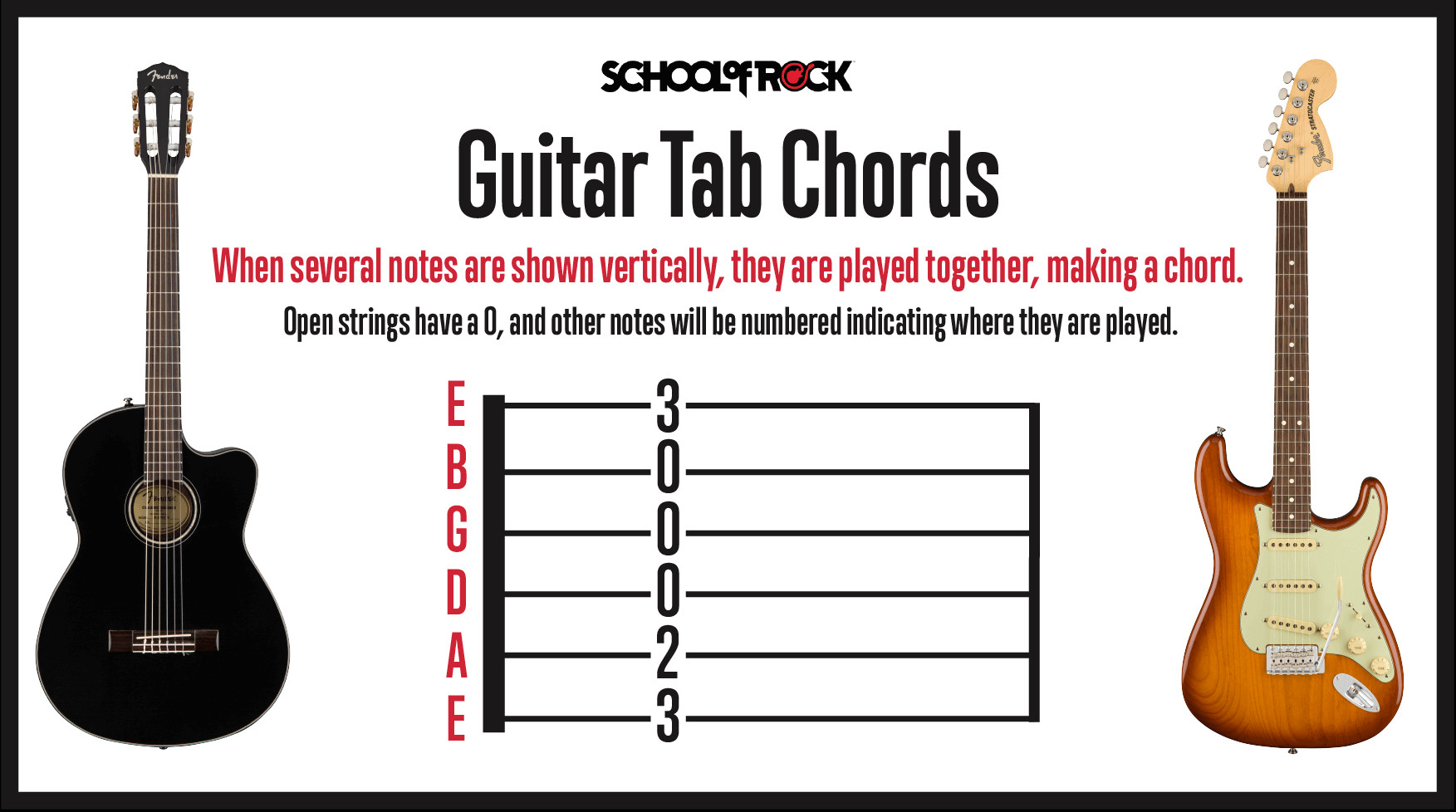 Guitar Tab Chords Explained
Guitar Tab Chords Explained
6. What About Guitar Tab Riffs?
Riffs are a mix of single notes and partial chords (like power chords). The same basic rules apply: vertical alignment indicates simultaneous notes. Riffs make learning songs more manageable by breaking them down into smaller, repeatable parts.
7. Guitar Tabs vs. Chord Charts: What’s the Difference?
A guitar tab differs from a standard chord chart in its presentation and information. A chord chart shows you where to place your fingers to form a chord and may indicate which fingers to use. Chord charts are often placed above the lyrics to show when chord changes occur.
Chord charts typically show only the essential notes of a chord, whereas tabs show all the nuances, like single notes, variations, or arpeggios. Chord charts are useful for understanding basic chord shapes, but guitar tabs help you play a song more accurately.
8. How to Interpret Fingers and Numbers in Tabs
Guitar tabs use numbers to represent frets, while chord charts use a numbering system to indicate which fingers to use. In chord charts, the index finger is typically labeled 1, the middle finger 2, the ring finger 3, and the pinky 4. Guitar tabs focus on fret numbers rather than finger placement, though easy guitar tabs may include chord charts to guide beginners.
9. Guitar Tab Symbols: What Do They Mean?
Beyond numbers and lines, guitar tabs use symbols to indicate specific techniques like bends, slides, and mutes. Understanding these symbols is crucial for playing accurately and expressively.
9.1. The Importance of Guitar Tuning
Before you start playing, ensure your guitar is properly tuned. Correct tuning is essential for the music to sound right. There are many resources available online, including tuning apps and guides on guitarplayers.net, to help you tune your guitar. According to research from the Berklee College of Music, in July 2025, proper tuning enhances the clarity and resonance of each note, ensuring that the intended sound is accurately produced.
10. Muting Guitar Notes: How Is It Done?
Muting is crucial in many rock styles and involves dampening the strings to control the sound.
10.1. How to Effectively Mute Guitar Notes
Muting can be done with either hand, though it’s most commonly performed with the picking hand. Muting adds dynamic variation to your playing and reduces unwanted noise, especially at high volumes.
10.2. Palm Muting: A Key Guitar Technique
Palm muting involves resting the palm of your picking hand lightly on the strings near the bridge to create a dampened sound. The tightness of the mute can vary, producing either a tight, rhythmic sound or a softer, more resonant tone. Guitar tabs indicate palm muting with “P.M.” above the muted section.
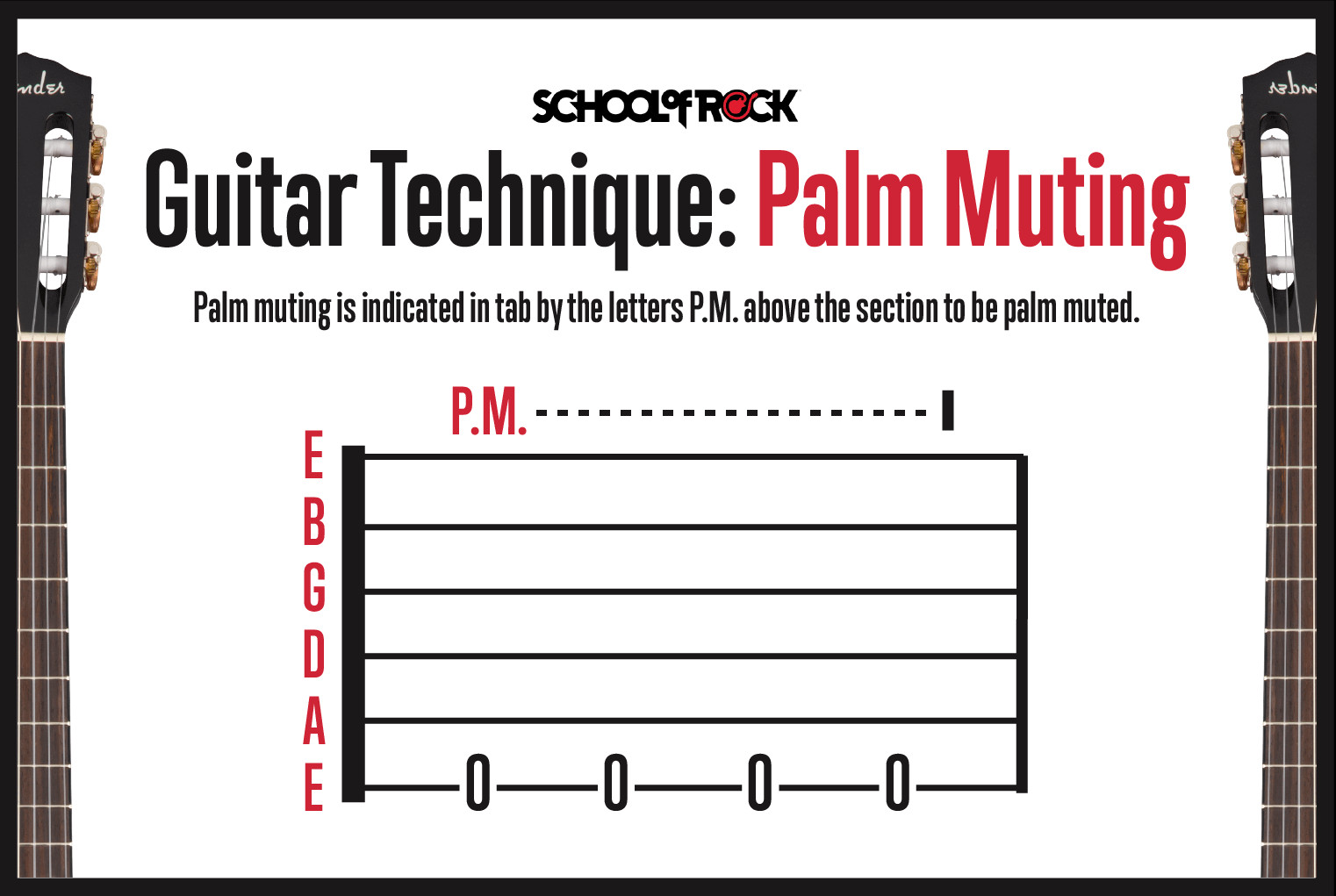 Palm Muting Technique
Palm Muting Technique
10.3. Muted Notes: Another Essential Technique
Muted notes, indicated by an “X” on the tab, are created by lightly touching the strings with your fretting hand without pressing down fully. This produces a percussive sound without a clear pitch.
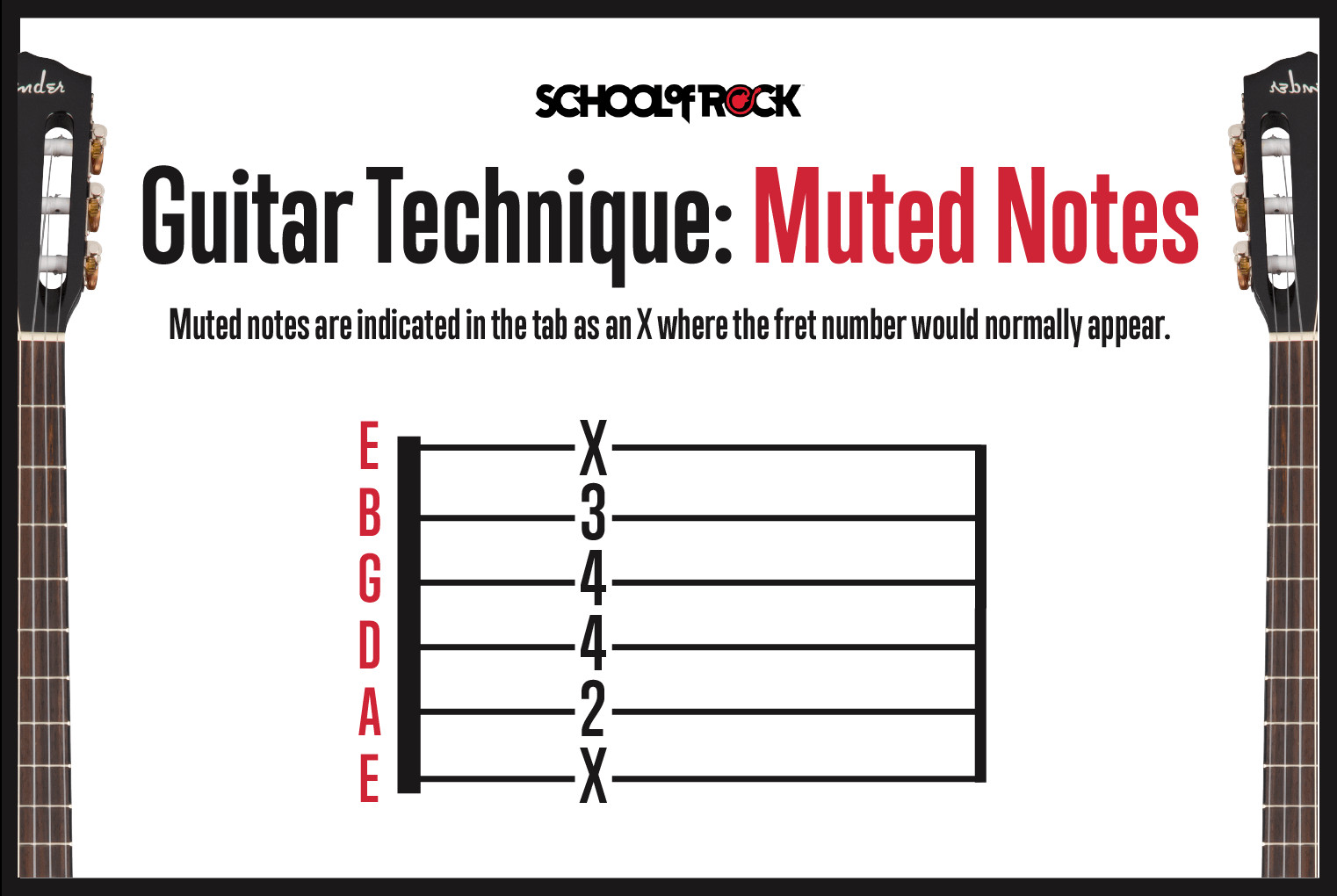 Muted Notes Technique
Muted Notes Technique
11. How to Bend Guitar Strings Like a Pro
String bending gives your playing a vocal, expressive quality by raising the pitch of a note.
11.1. How to Correctly Bend Guitar Strings
Bending involves pushing or pulling the string across the fretboard rather than pressing straight down. Tabs indicate bends with a curved arrow, often specifying the amount of the bend (e.g., ½ step, full step).
11.2. Bending Strings: An Essential Guitar Technique
Use two or three fingers for bending, with the main finger (usually the ring finger) supported by the others to provide strength and control.
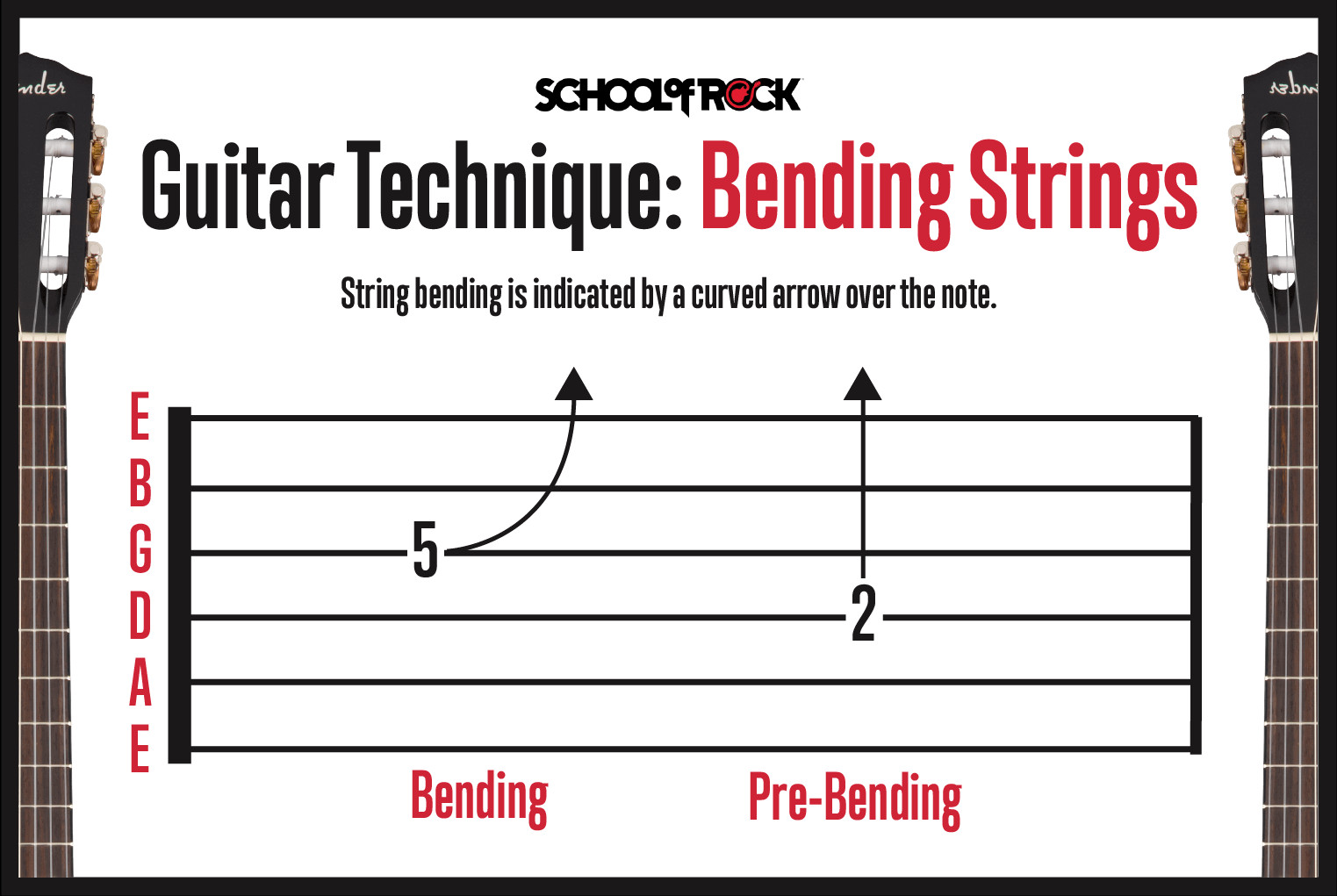 String Bending Technique
String Bending Technique
11.3. Pre-Bending: What Is It?
Pre-bending involves bending the string before picking the note, then releasing the bend or bending further to a new pitch. Tabs show this with an upward arrow indicating the bend, followed by a curved arrow showing the release or further bend.
12. Sliding Guitar Notes: What to Know
Sliding involves moving your finger from one note to another without lifting it from the string.
12.1. How to Slide Up
To slide up, move your finger to a higher fret, indicated by a line that slopes upward toward the higher note.
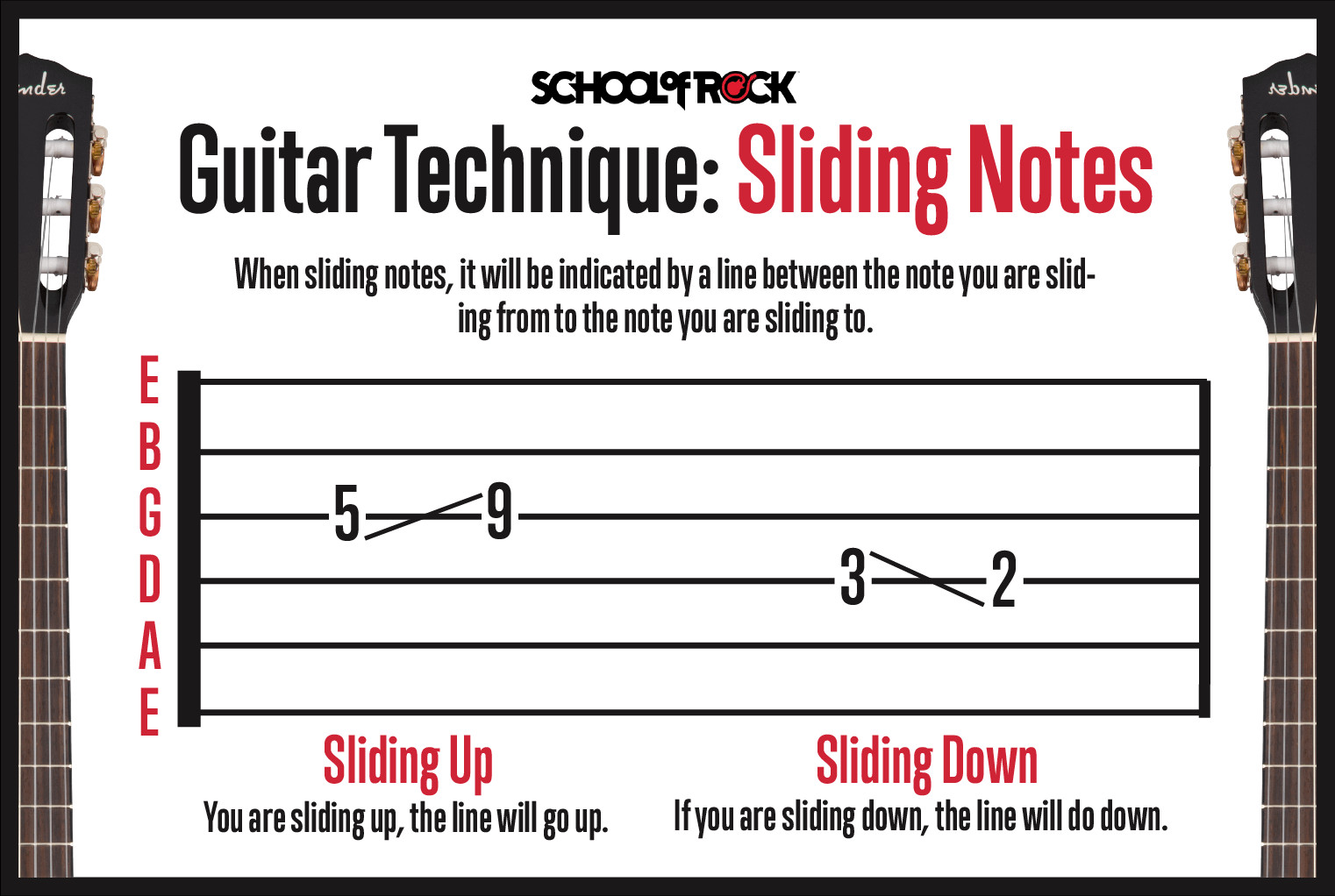 Sliding Up Technique
Sliding Up Technique
12.2. How to Slide Down
To slide down, move your finger to a lower fret, indicated by a line that slopes downward toward the lower note.
13. Playing Hammer-Ons: A Detailed Guide
A hammer-on involves striking a string with your fretting finger hard enough to sound a note without picking it.
13.1. How to Properly Execute Hammer-Ons
Strike the string firmly with your finger to produce a clear note. Tabs show hammer-ons with an “H” connected by an arc.
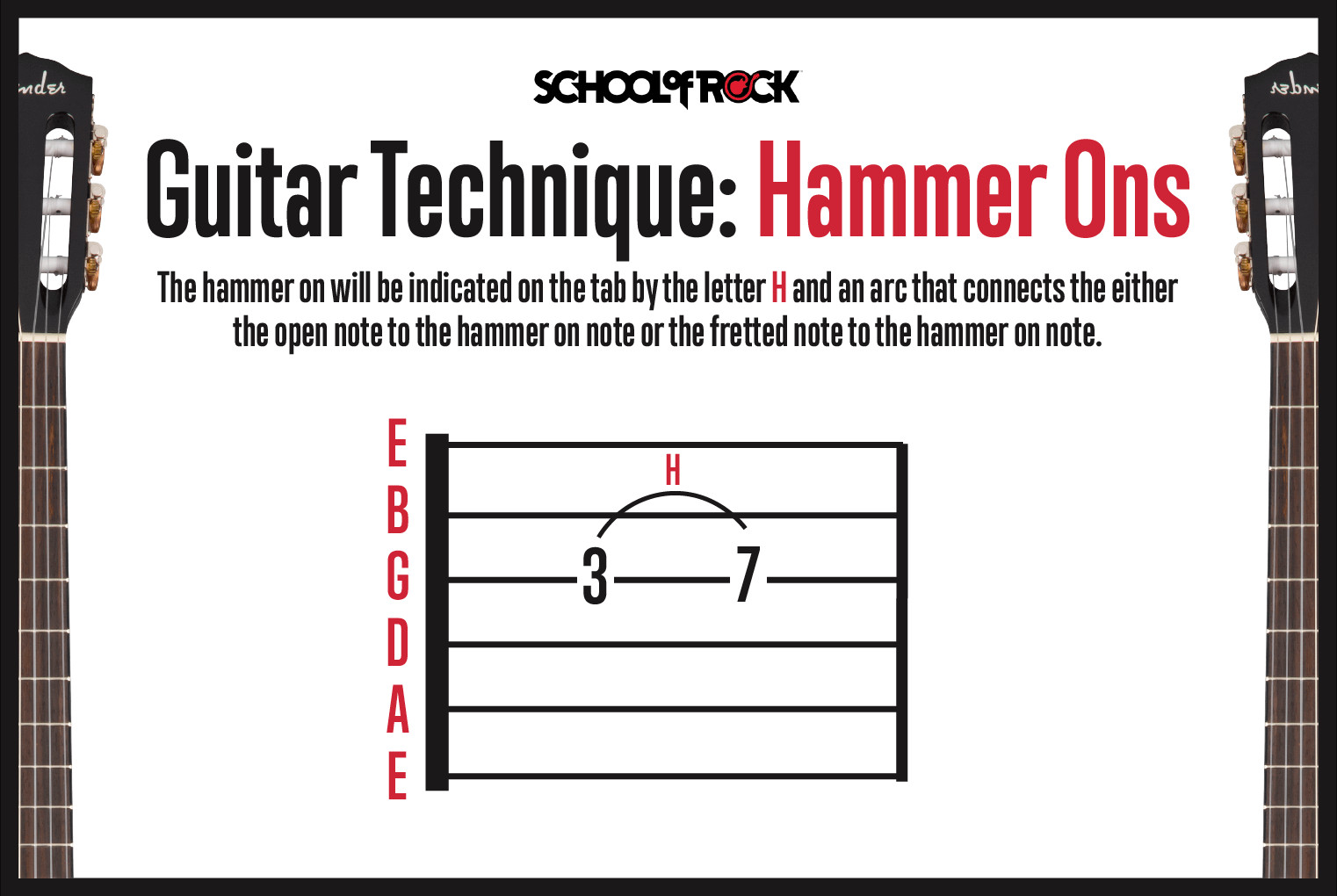 Hammer-On Technique
Hammer-On Technique
14. Playing Pull-Offs: The Reverse of Hammer-Ons
A pull-off involves plucking a string with your fretting finger to sound a lower note.
14.1. How to Correctly Execute Pull-Offs
Pull your finger off the string in a way that it plucks the string, sounding the note. Tabs show pull-offs with a “P” connected by an arc.
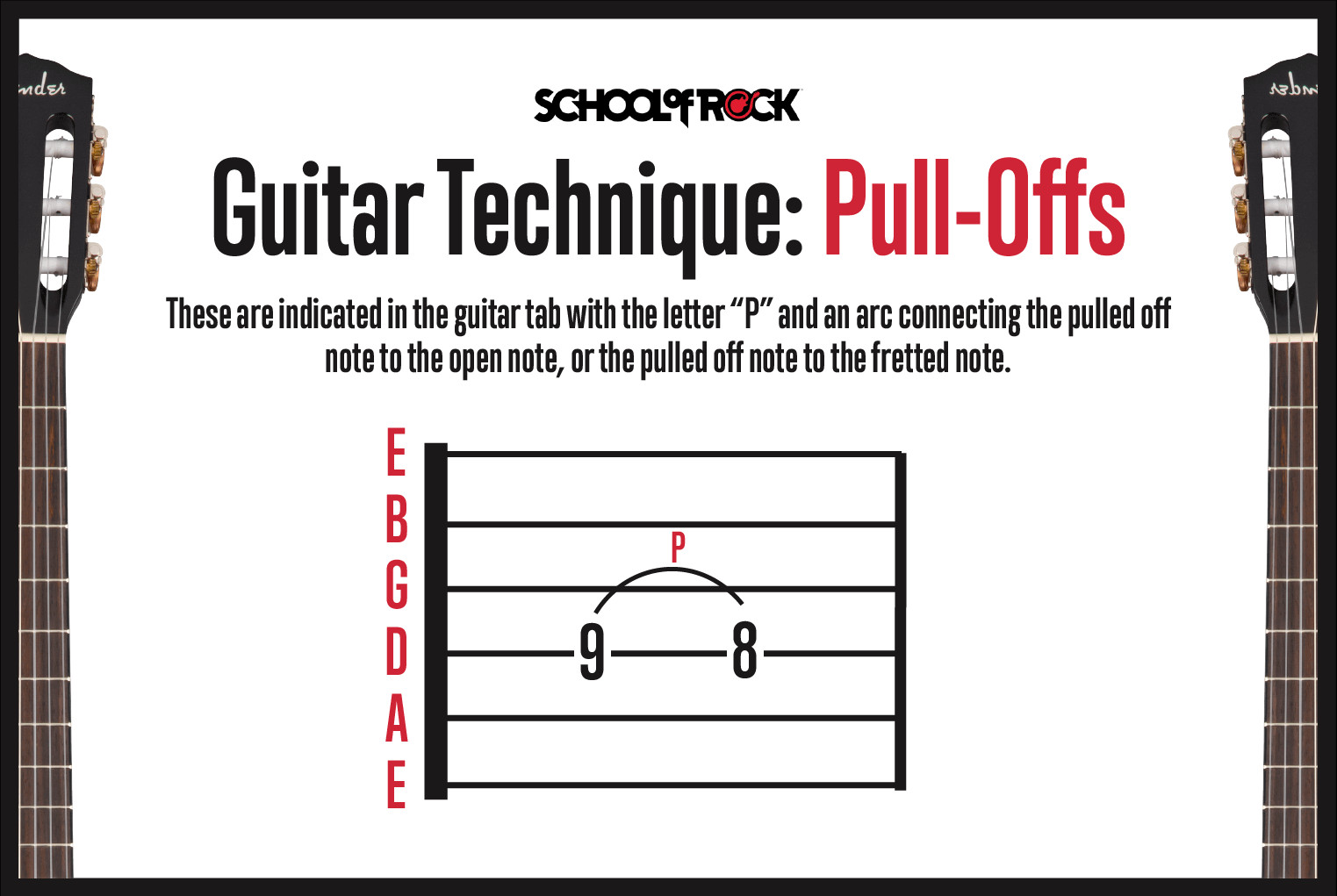 Pull-Off Technique
Pull-Off Technique
15. Vibrato: Adding Emotion to Your Playing
Vibrato involves slightly and repeatedly bending a note to add warmth and expression.
15.1. How to Apply Vibrato Effectively
Apply a slight bend and release repeatedly, without fully releasing the note. Tabs indicate vibrato with a zig-zag line above the staff, with longer lines indicating more sustained vibrato.
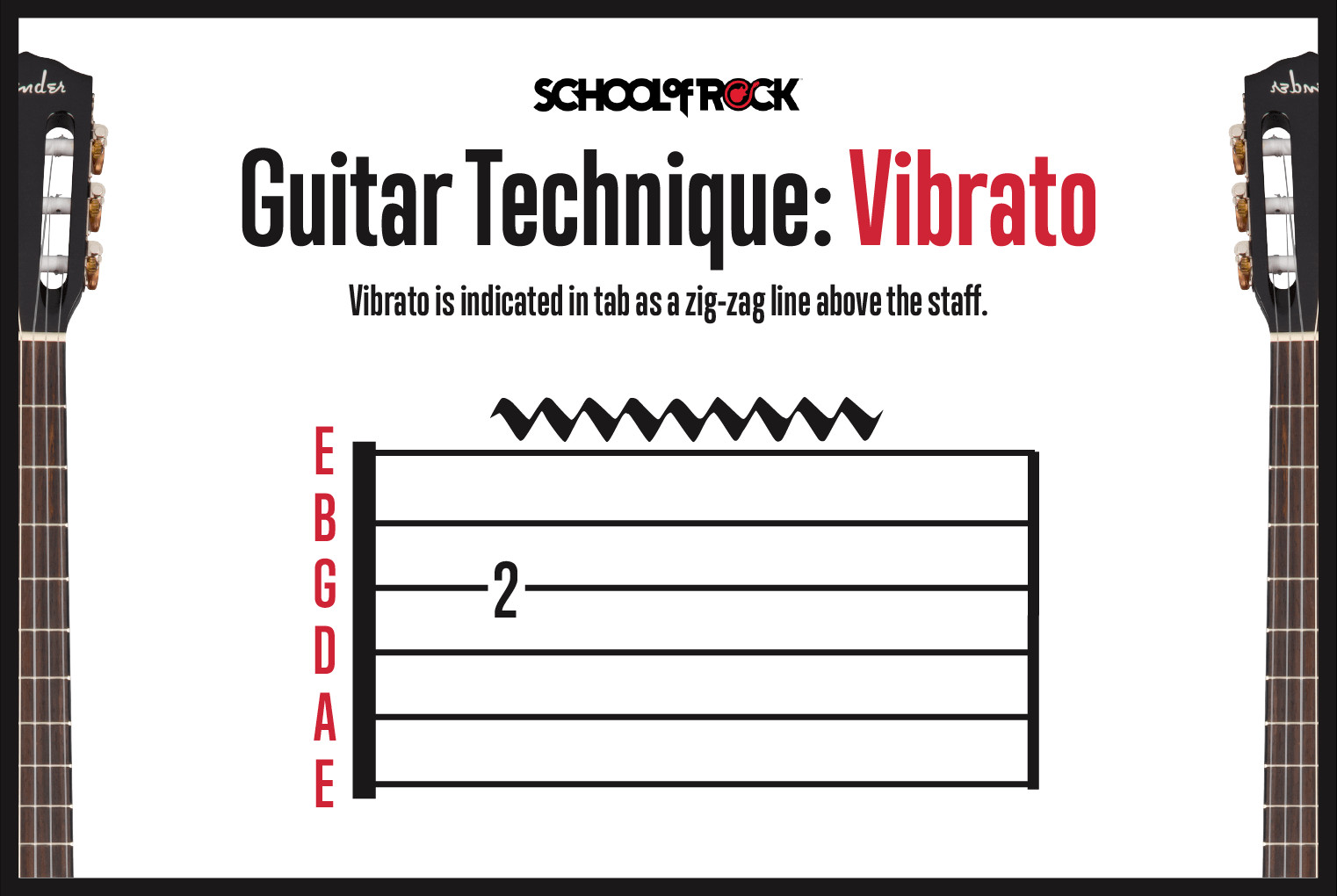 Vibrato Technique
Vibrato Technique
16. Tapping: A Modern Guitar Technique
Tapping involves using a finger on your picking hand to strike the strings against the fretboard.
16.1. How to Finger Tap Correctly
Use a finger on your picking hand to “tap” a note, similar to a hammer-on. Tabs indicate tapping with a “T” above the note.
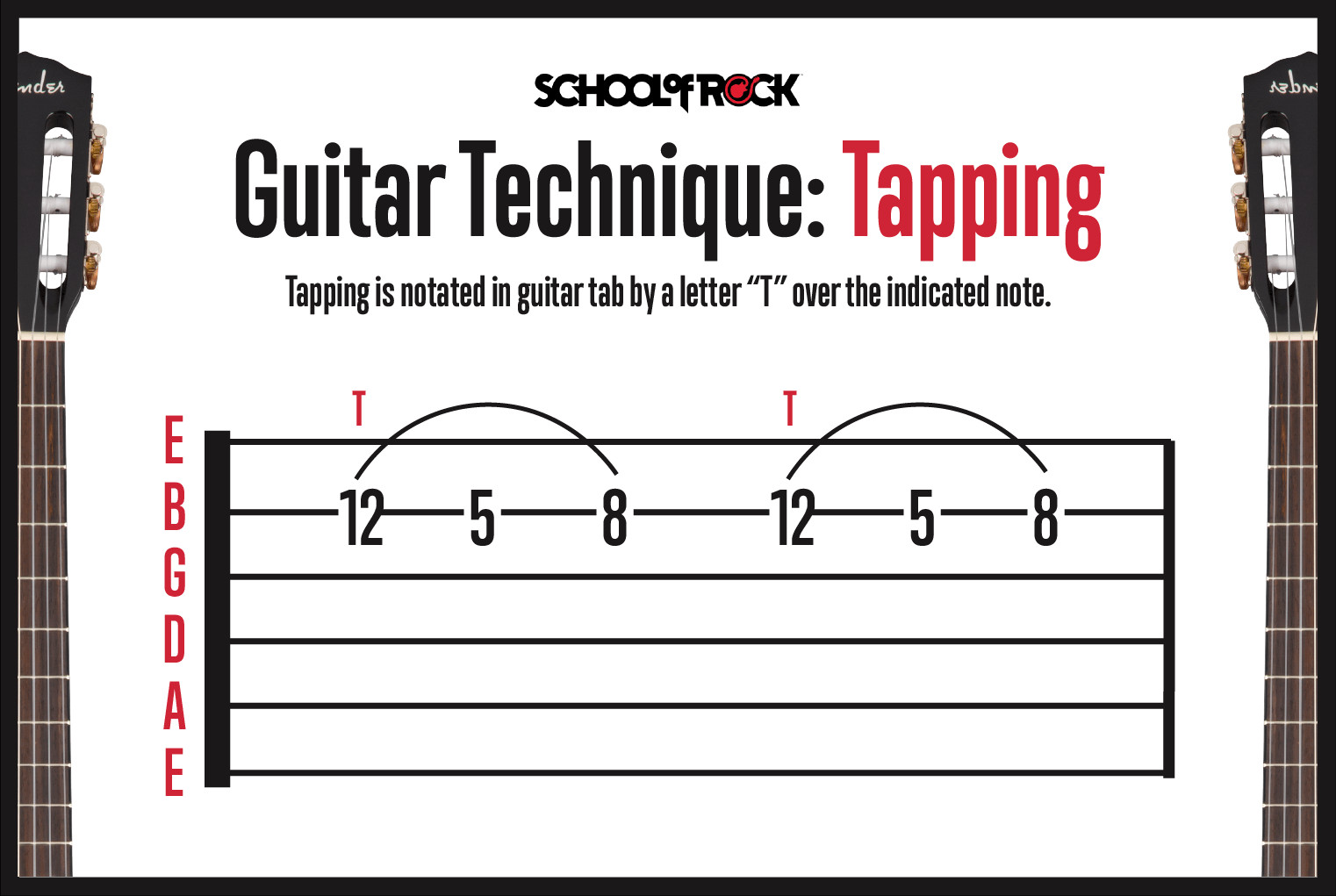 Tapping Technique
Tapping Technique
16.2. Two-Handed Tapping: An Advanced Technique
Two-handed tapping involves using both hands to tap notes independently on the fretboard, creating complex melodies and harmonies.
17. Strumming: Essential for Rhythm Guitar
Strumming involves brushing your pick across the strings to play chords.
17.1. How to Strum Guitar Notes
Use downstrokes (indicated by a downward-facing symbol) and upstrokes (indicated by a “V”) in various patterns to create different rhythms.
 Strumming Technique
Strumming Technique
17.2. Downstrokes and Upstrokes: What’s the Difference?
Downstrokes involve moving the pick downward across the strings, while upstrokes involve moving the pick upward. Alternating these strokes is key to many strumming patterns.
18. Ready to Explore More Guitar Techniques?
Now that you’ve learned how to read guitar tabs and understand various guitar techniques, it’s time to start playing.
19. Top 5 Search Intentions for “How to Read a Guitar Tab for Beginners”
- Basic Tab Reading: Users want to understand the basics of guitar tablature, including what the lines and numbers represent.
- Technique Interpretation: Users seek to understand symbols and notations for techniques like bends, slides, and mutes in guitar tabs.
- Tab vs. Standard Notation: Users want to compare guitar tabs with standard music notation and understand their respective advantages.
- Learning Resources: Users search for resources like websites, apps, or tutorials that provide guitar tabs for popular songs.
- Troubleshooting: Users look for solutions to common problems encountered while reading and interpreting guitar tabs.
20. FAQ: Mastering Guitar Tabs
20.1. Can I learn guitar using only tabs?
Yes, many guitarists learn to play using only tabs, especially beginners. Tabs provide a visual representation of the fretboard, making it easier to learn songs without reading standard music notation. However, understanding basic music theory can enhance your learning experience.
20.2. How do I find reliable guitar tabs online?
Look for tabs on reputable websites and apps that offer accurate and well-formatted tablature. Sites like guitarplayers.net often have curated collections and user-submitted tabs that are reviewed for accuracy.
20.3. What if a tab doesn’t sound right?
If a tab doesn’t sound right, double-check your tuning and compare the tab with a recording of the song. Sometimes, tabs may contain errors or represent different versions of the song.
20.4. Are there apps to help me read guitar tabs?
Yes, there are several apps available that can help you read guitar tabs, often with features like scrolling tabs, adjustable speed, and backing tracks. Some popular apps include Ultimate Guitar, Guitar Tabs, and Songsterr.
20.5. How important is it to learn standard music notation as well?
While not essential, learning standard music notation can broaden your musical understanding and open up new possibilities, such as playing in ensembles and reading sheet music. It provides a deeper insight into music theory and composition.
20.6. What are the common mistakes beginners make when reading guitar tabs?
Common mistakes include misreading fret numbers, neglecting to check the tuning, and not understanding the symbols for various techniques like bends and slides.
20.7. How do I practice reading guitar tabs effectively?
Start with simple tabs of songs you know and gradually increase the difficulty. Practice regularly, focusing on accuracy and timing. Use a metronome to improve your rhythm.
20.8. Can guitar tabs show rhythm and timing?
While guitar tabs primarily show fret positions, they often include some indication of rhythm and timing, such as note durations and time signatures. However, they may not be as precise as standard music notation.
20.9. How do I create my own guitar tabs?
You can create your own guitar tabs using text editors or specialized tab editing software. Start by listening to the song and transcribing the notes onto the tab format, indicating the fret numbers and techniques used.
20.10. What do the numbers on guitar tabs mean?
The numbers on guitar tabs represent the fret number on the corresponding string. “0” indicates an open string, while “1” indicates the first fret, “2” the second fret, and so on.
21. Call to Action: Start Your Guitar Journey Today
Ready to start playing your favorite songs? Visit guitarplayers.net for lessons, sheet music, and a community of guitar enthusiasts ready to help you along the way. Whether you’re just starting or looking to improve your skills, guitarplayers.net has everything you need.
Address: 1140 Boylston Street, Boston, MA 02215, United States
Phone: +1 (617) 747-2261
Website: guitarplayers.net

